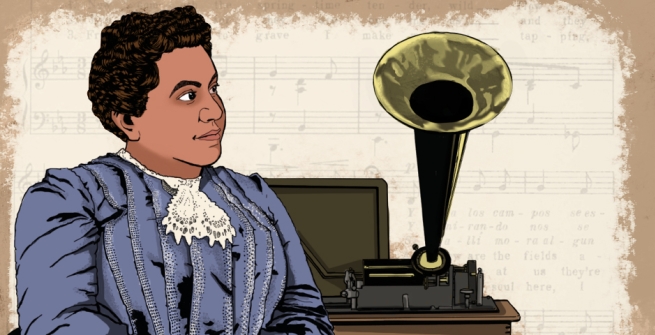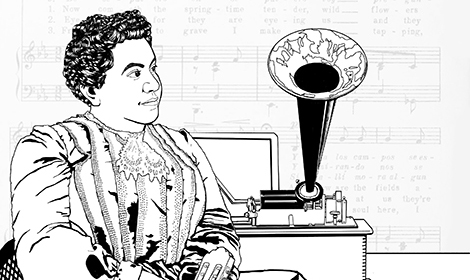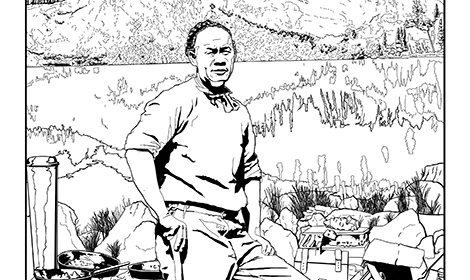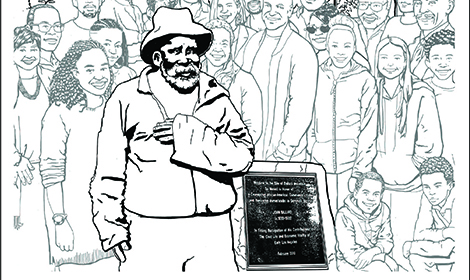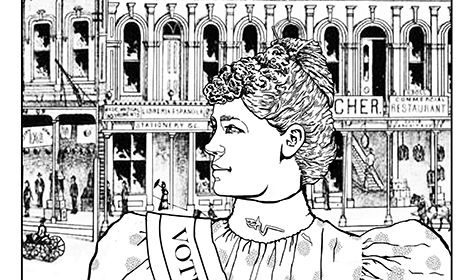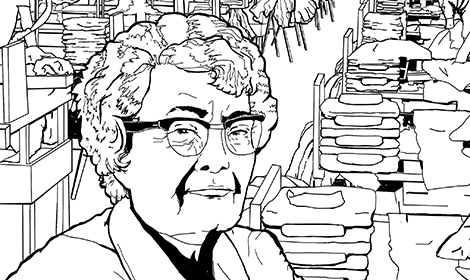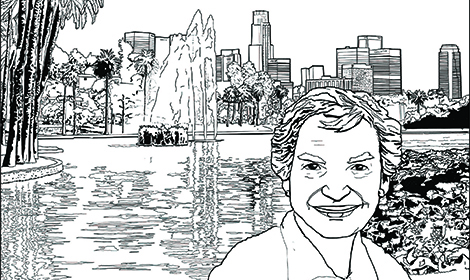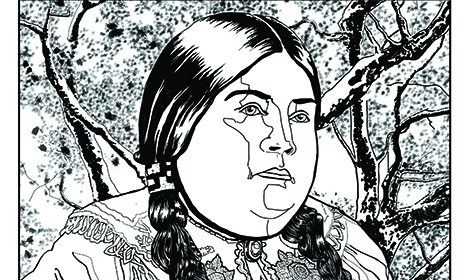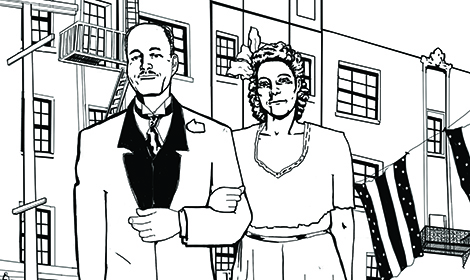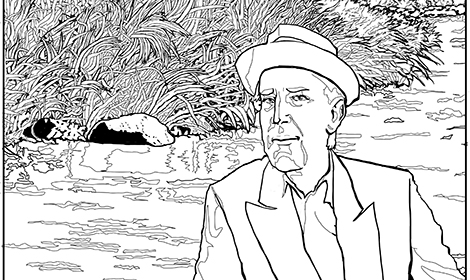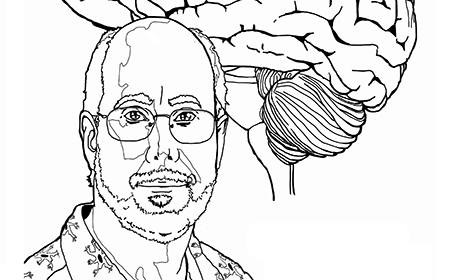In celebration of Octavia E. Butler’s birthday this year, the Octavia Lab began making coloring pages to celebrate lesser-known heroes in California. As lab staff, we were deeply affected by the COVID-19 pandemic and inspired by the call to action from the Black Lives Movement. We wanted a way for us to bring joy to our communities by celebrating and amplifying unheard voices.
We are inspired by Octavia E. Butler’s literacy volunteer application, where she writes as the reason she wanted to volunteer—“I want to help.” With this thought in mind, we, as a team, searched for people who have passed away, lived in California, and performed uplifting acts for their community. As a learning lab, we hope that these hidden heroes inspire you to learn more about your local history and discover more unsung heroes. Please share these coloring sheets with your friends and family and be inspired by the work they did to help us get to where we are today.
What follows is the beginnings of our list of people who have answered the call of wanting to help.
Manuela García (1867–1931)
Manuela García was a Los Angeles singer who intimately knew nineteenth-century Spanish-language songs. Between 1904 to 1905, Charles Lummis, with his interest in the Southwest, in the documentation of culture, recorded 300 Mexican folk songs on wax cylinders and later published them in his 1923 book, Spanish Songs of Old California. García recorded and sang from memory around 150 Spanish-language songs for Lummis’ project. In addition to singing for Lummis, García gave him her notebook containing the words to 149 songs.
In 1905, Lummis took the position as City Librarian of the Los Angeles Public Library. Manuela García’s family lived in an adobe on South Olive Street on Bunker Hill in what is now Downtown Los Angeles.
Tie Sing (date unknown–1918)
Tie Sing was a Chinese American who served as head chef for the U.S. Geological Survey (USGS) for 28 years. Sing first came to California from China looking for gold with little success. Because of intense racial discrimination, Asian Americans were limited in their job opportunities leading Sing to become a cook. His reputation as a backcountry chef and his work feeding mapmakers was so legendary that he became known as the “Gourmet Chef of the Sierras.” In 1899, the USGS named Yosemite’s Sing Peak in his honor.
Sing famously cooked for the Mather Mountain parties in 1915, which was a camping campaign to show politicians and industrialists the splendor of Yosemite and inspire their support for nature preservation efforts. The Mather Mountain Parties were so successful that the National Park Service was established through the Organic Act of 1916.
John Ballard (c. 1830–1905)
John Ballard was a blacksmith and homesteader who settled the Santa Monica mountains. Ballard was born in Kentucky as a slave before being freed and relocating to Los Angeles in 1859. In California, Ballard became a prominent member of Los Angeles’s African American community, helping to co-found the city’s African Methodist Episcopal (AME) Church. In 2010, the name of a mountain where Ballard settled was renamed Ballard Mountain, in his honor. John Ballard is pictured here with his descendants in front of the mountain that bears his name.
Prior to the two-year campaign to getting the mountain renamed, the area Ballard lived on was referred to by the US Geological Survey as N**head until the 1960s when the name was then changed to Negrohead.
Some noteworthy descendants of John Ballard include:
- Dr. Claudius Ballard - UC Berkeley medical school in 1913. Served in WWI as a First Lieutenant in the Medical Reserve Corp. Croix de Guerre award.
- Reginald Ballard - During World War II, trained with the Tuskegee Airmen. Later, served as a Los Angeles firefighter, challenged the department’s segregation policies.
Mary Emily Foy (1862–1962)
Mary Emily Foy was the first woman to serve as Los Angeles City Librarian (1880-1884). Foy was born in Los Angeles and attended the State Normal School where she trained to become an educator, later teaching at Los Angeles High School. A tireless advocate for women's suffrage, Foy was a major figure in the California movement to give women the right to vote. Foy’s interest in civic and state politics included a run for Congress in 1934. Upon her death in 1962, Foy became the first and only woman to be laid in state at Los Angeles City Hall.
In 2020, the Los Angeles Public Library commemorated Foy's accomplishments by installing a plaque in her honor in the Rotunda of Central Library.
Anita Andrade Castro (1907–1980)
Anita Andrade Castro was a Los Angeles union activist and organizer. Born in the former Yugoslavia, Castro’s family emigrated to Argentina before arriving in Los Angeles in the 1930s. While employed as a garment worker in L.A., Castro witnessed, firsthand, the substandard working conditions that she would work to fight against. Initially recruited by the Garment Workers Union as a translator, her participation grew into a lifelong career of activism. Castro was arrested over forty times, and demonstrated that worker rights are worth fighting for.
Sister Karen Boccalero (1933–1997)
Sister Karen Boccalero was a nun, artist, and founder of Self-Help Graphics & Art, a community art center in East Los Angeles. Raised in Los Angeles, Boccalero had a lifelong interest in art that continued after she joined the Franciscan order. After studying art at Temple University, she returned to East Los Angeles and opened the first iteration of Self-Help Graphics & Art in the garage behind the house she shared with her fellow nuns. Since 1970, Self-Help Graphics & Art has provided a foundation for Chicanx artists to cultivate creative expression and solidify their identities.
Helen Agcaoili Summers Brown (1915–2011)
Helen Agcaoili Summers Brown was an educator, founder of the Filipino American Library, and co-founder of the Los Angeles chapter of the Filipino American National Historical Society. Born in Manila, she immigrated with her family to Los Angeles, where she attended UCLA and graduated with a Master’s in Education. During World War II, she worked as a welder before becoming a third-grade teacher for the Los Angeles Unified School District. Throughout her lifetime, Brown amassed a collection of Pilipinx books, pamphlets, photographs, and artifacts that served as the foundation of the Filipino American Library enriching scholarship related to the Pilipinx community.
In 1985, she was granted space in the basement of the Filipino Christian Church and founded the Pilipino American Reading Room and Library. After securing a larger location in 2000, the library moved to Temple Street and changed its name to the Filipino-American Library where it served the community for over another decade. Upon closing, its collections were distributed to the Echo Park branch of the Los Angeles Public Library and USC Libraries.
Ah-Wane-U Sharon (Oneida/Onyota'a:ka) (c.1867–1935)
Ah-Wane-U Sharon was a Native American businesswoman and founder of the Los Angeles Wigwam Club of America. The Wigwam Club was formed to serve the needs of disabled Native American soldiers but expanded to help serve the needs of native families. A guiding principle of the club was to provide pathways into middle-class, western society while still retaining one’s Native American roots. The Wigwam Club’s lasting contribution was the 1928 founding of an annual inter-tribal celebration of Native American culture, the Indian Day Pow Wow held in Sycamore Grove Park in Highland Park.
Dr. Vada Watson (1885–1972) and Dr. John Alexander Somerville (c.1882–1973)
Drs. Vada Watson and John Alexander Somerville were a married couple who became dentists, leading civil rights activists, and accomplished entrepreneurs in early 20th century Los Angeles. John Somerville, a Jamaican immigrant, became the first black graduate from USC’s School of Dentistry. His wife, Vada Watson became the USC School of Dentistry’s second black graduate and the first African American woman to gain her license to practice dentistry in California. The Somervilles co-founded the first Los Angeles chapter of the National Association for the Advancement of Colored People (NAACP) and became entrepreneurs when they built the Hotel Somerville, an upscale hotel catering to African Americans who were excluded from the many whites-only establishments in Los Angeles. That hotel, depicted here, was later renamed the Dunbar Hotel and was the focal point of the famous blues and jazz scene that exploded on Central Avenue from the 1920s through the 1950s.
Lewis MacAdams (1944–2020)
Lewis MacAdams was a poet, journalist, and visionary advocate for the revitalization of the Los Angeles River. In 1986, he launched a crusade to restore the wetlands of the river and increase public access. His organization, the Friends of the Los Angeles River (FoLAR) continues to promote river clean-up, education, and nature conservation.
Dr. Virginia Uribe (1933–2019)
Dr. Virginia Uribe was a Los Angeles Unified School District science teacher, with a PhD in psychology. In an era when most school staff remained in the closet, Uribe came out and began a career of support and advocacy for LGBT+ (lesbian, gay, bisexual, transgender plus) youth. In 1984, in response to high drop-out and suicide rates among gay teens, Uribe started Project 10 at Fairfax High School to counsel LGBT+ students experiencing discrimination and harassment. LAUSD expanded the program to over 40 campuses. The first of its kind, Project 10 became a model for LGBTQIA (lesbian, gay, bisexual, transgender, queer, intersex, and asexual) support groups on campus all over the nation.
Dr. Ben Barres (1954–2017)
Dr. Ben Barres was a transgendered neurobiologist whose research focused on the previously unstudied glial cells. Glia make up nine out of the ten cells in the human brain and Barres' research demonstrated their function in maintaining neural activity. This research has been monumental in our understanding of Parkinson's, Alzheimer's, and other diseases that involve brain tissue degeneration. Barres was a fierce advocate for his students, for women's ability in the sciences, and for representation from people of color and lesbian, gay, bisexual, transgender, queer, intersex, and asexual (LGBTQIA) scientists.
Land Acknowledgement: The Octavia Lab acknowledges that we are on the traditional and unceded territory of peoples who have been known as the Kizh, Gabrileño, and Tongva throughout their several thousand-year stewardship of this region.
—Written with the help of Vi Ha, Mayra Cervantes, Amanda Mellor, Richard Acero, Christina Rice, Stella Mittelbach, Nicholas Beyelia, Ani Boyadjian, Bob Timmermann, Jimmy Tokeshi and Imani Harris.
